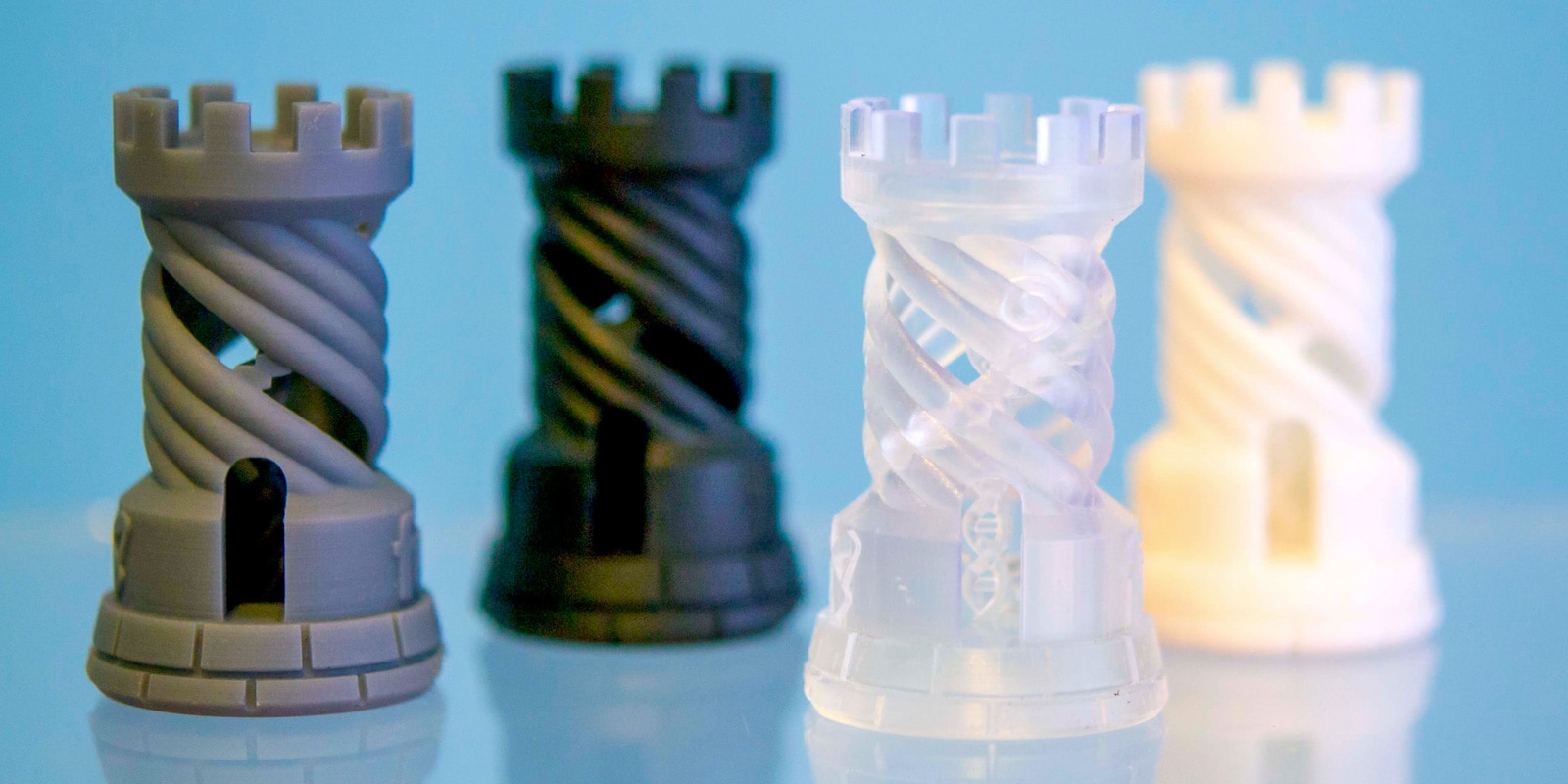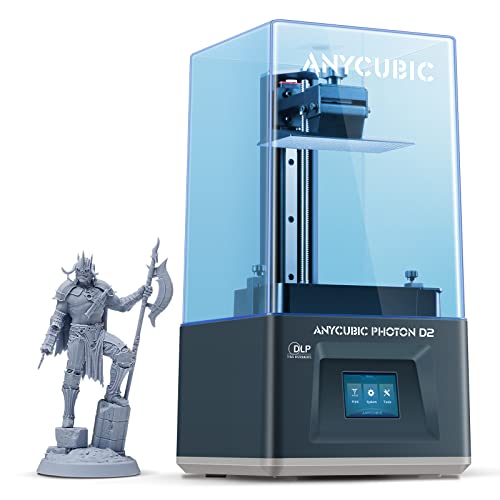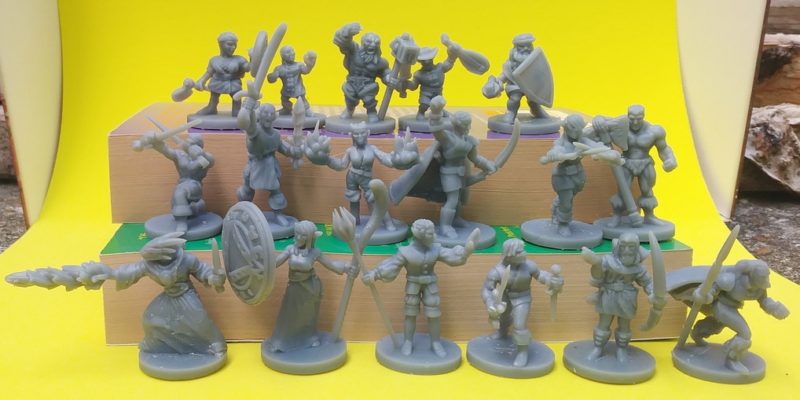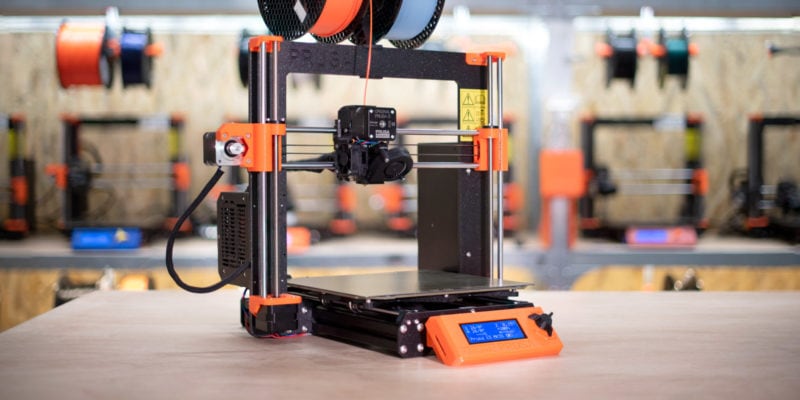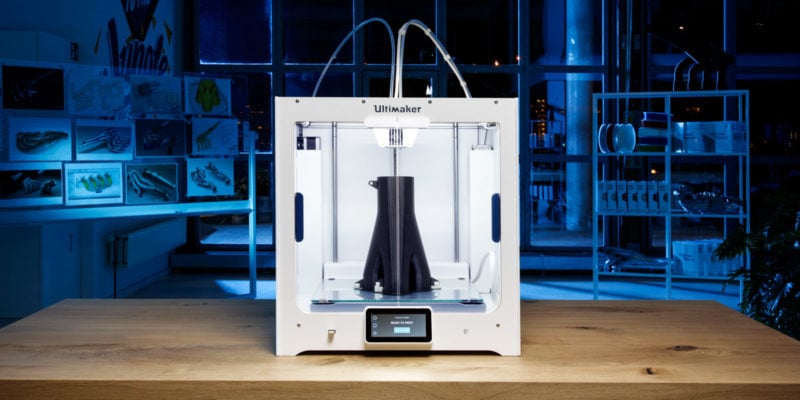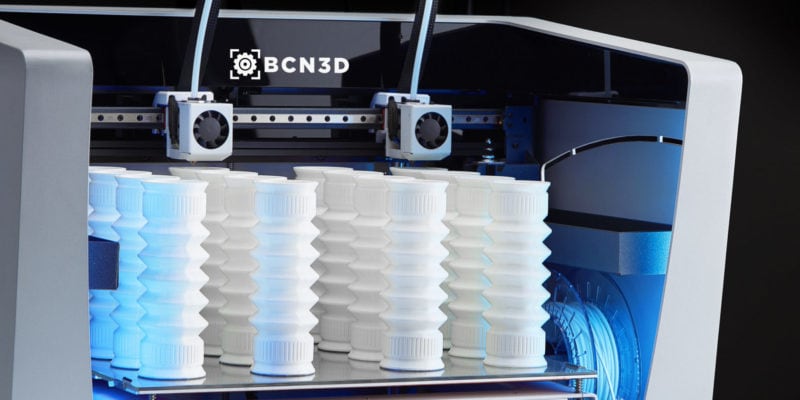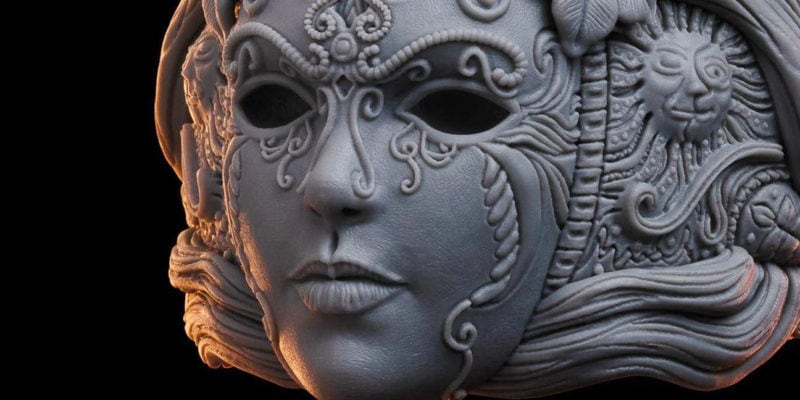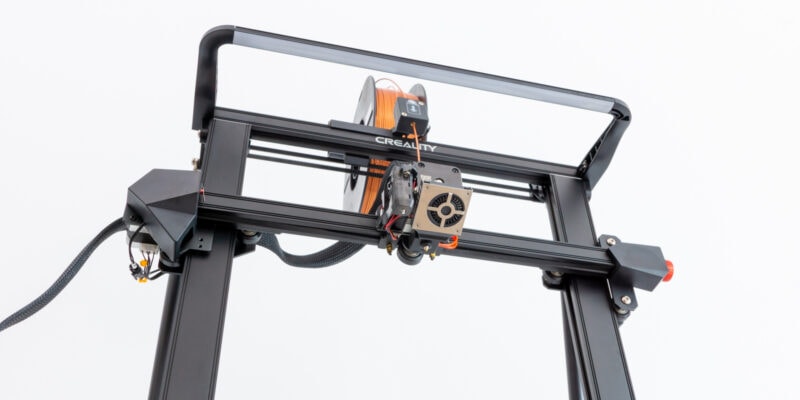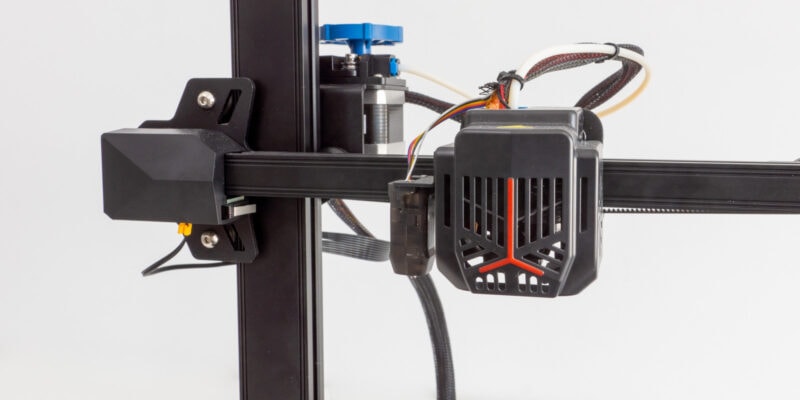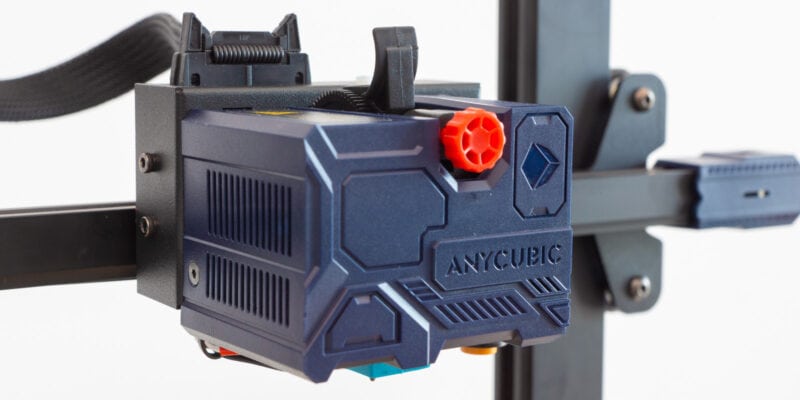Who’d have guessed a few years ago that you could 3D print, paint, and finish miniatures from the comfort of your home? The miniature hobby is now more than just buying models, and 3D printing minis has become its own thing.
With high-quality 3D printers, you can get a miniature model that’s equal to the quality of a store-bought one. For instance, the Elegoo Saturn 2 is capable of printing at a remarkable 28.5 microns of resolution, which is thinner than a human hair. It’s one of the few reasons we’ve named it the overall best 3D printer for miniatures.
In this post, we’ll take a look at some of the finest 3D printers for miniatures and break them down by category. We have a full buyer’s guide and answers to some of the most frequently asked questions about printing quality miniatures at the end.
Read on as we embark on the journey through the top contenders and bring your miniature to life, layer by layer.
| Product | Print volume | Type | Price | Best Offer |
|---|---|---|---|---|
| Elegoo Saturn 2 | 219 x 123 x 250 mm | MSLA | $380 | |
| Phrozen Sonic Mini 8K | 165 x 72 x 180 mm | MSLA | $450 | |
| Anycubic Photon Mono 2 | 165 x 89 x 143 mm | MSLA | $209 | |
| Creality CR-M4 | 450 x 450 x 470 mm | FDM | $1099 | |
| Anycubic Photon Mono M5S | 200 x 123 x 218 mm | MSLA/DLP | $499 | |
| Phrozen Sonic Mini 4K | 135 x 75 x 130 mm | MSLA/DLP | $350 | |
| Anycubic Photon D2 | 165 x 131 x 73 mm | DLP | $679 | |
| Creality Ender 3 V2 | 220 x 220 x 250 mm | FDM | $279 |
Best 3D Printers for Miniatures in 2024
The Saturn 2 is bigger, brighter, and better than its Saturn predecessor in almost every way. This second-generation printer does a lot of things well and is a great choice for 3D printing miniatures.
Impressive features of the Saturn 2 are its big 10-inch screen and a build volume of 219 x 123 x 250 mm. The 8K resolution of the monochrome display is another improvement. With this setup, you get an XY resolution of 28.5 microns. This is enough to print several of your favorite tabletop miniatures at once, at high speed, and with all of their smaller features kept.
The printer has a front-facing power button and a ventilation hole in the case, both of which are upgrades over the original. The button makes it much simpler to start the machine, and plugging in a supplementary ventilation line is a breeze with the casing outlet.
There is also an air filter that you can just plug in and use. Even though the purifier is not sufficient on its own given the massive build volume. The 2 also lacks the original’s Ethernet interface, limiting networking options.
The Saturn 2 does do a lot of things right as a whole. Brand-new LED projectors, a reimagined touchscreen interface, and a distinctive appearance. The price of under $500 is also right in terms of quality and abilities. This is “The” best 3D printer for miniatures if you need high-quality minis and want to print many smaller models or several huge ones at once.
Standout Features
- 8K LCD screen
- Big build volume
- Dual linear rails
Technical Details |
|
|---|---|
| Technology | MSLA |
| Build volume | 219 x 123 x 250 mm |
| Layer height | 0.1-0.2mm |
| Screen resolution | 7680 x 4320 |
| XY-axis resolution | 0.028 mm (28.5 microns) |
What We Like
- Built-in purifier
- Tempered glass protector
- Excellent print details
Could Be Better
- Steep learning curve
- Quality control issues
The Phrozen Sonic Mini 8K is a bit different from the rest of the 8K printers. With a much better LCD screen and superior print quality, it stands out from the crowd.
The screen on the Mini 8K has an XY resolution of 22 microns. It’s a big change from the Mini 4K, which had a maximum resolution of 35 microns. The higher resolution makes the models clearer and makes the details stand out. It also makes the lines between the layers almost impossible to see.
Phrozen has added an extra linear rail on the Z-axis, which makes the printer more stable and improves the quality of your printed miniatures. The UV light source is also improved so that light is projected in a more uniform manner. It makes the picture sharper and speeds up the resin curing.
The Sonic Mini 8K features a new laser-cut build plate that holds prints very well. In fact, sometimes too well. Print removal is a tough job on the Mini 8K, and it can take a few tries before you get the hang of it.
Some users also feel like the print space is too small for big resin 3D models. The touchscreen interface is also showing its age, and a larger front display would have been a welcome improvement from Phrozen.
Currently, on the hobby market, the Sonic Mini 8K is one of the sharpest 3D printers to print miniatures with right now. The prints are clear, show all the features, and are of the highest quality. This printer is great if you are looking for a quality resin printer and put print quality above everything else.
Standout Features
- Sharp 8K screen
- Frosted laser build plate
- Robust dual linear rails
Technical Details |
|
|---|---|
| Technology | MSLA |
| Build volume | 165 x 72 x 180 mm |
| Layer height | 0.1-0.30 mm |
| Screen resolution | 7500 x 3240 |
| XY-axis resolution | 0.022 mm (22 microns) |
What We Like
- Highest print resolution
- Prints adhere firmly to bed
- Excellent customer support
Could Be Better
- Limited print volume
- Dated touch display
The Anycubic Photon Mono 2 is the company’s newest resin 3D printer in the low-price range. It has some cool improvements over the Photon Mono 4K and is a great choice for people who want to buy their first resin 3D printer to print miniature models.
A notable improvement on the Mono 2 has its screen, with more pixels and a bigger size. Even though the print area is bigger, you still get the same 35 microns XY precision as with the Mono 4K. So you can print minis that are a little bit bigger while keeping all their small details.
The build plate comes with a laser-engraved checkerboard design. This design makes your prints stick better to the bed and makes sure that the models stay put on the printing surface.
The UV light source is also brand new, and it is made to light up the LCD screen more evenly. The direct result is that your D&D prints will have less obvious layer lines and a smoother surface. Plus, it helps the resin harden faster, so you can print a nice layer in a rapid 1.5–3 seconds.
All of these changes are good, but the printer still doesn’t have an air filter or WiFi. An air filter would have been great to cut down on the smell and toxic fumes from the resin, and WiFi is pretty much a standard in 2023.
These are still fair trade-offs, and the benefits of the price far outweigh them. You can get a resin printer that looks as good as it works for around $200. If you want to print miniatures but have a restricted budget, this printer is an excellent option.
Standout Features
- Laser-engraved build plate
- Upgraded Turbo Light Matrix
- Large print volume
Technical Details |
|
|---|---|
| Technology | MSLA |
| Build volume | 165 x 89 x 143 mm |
| Layer height | 0.1-0.3 mm |
| Screen resolution | 4096 x 2560 |
| XY-axis resolution | 0.035 mm (35 microns) |
What We Like
- Easy print removal
- Scratch-protector on screen
- High 4K print detail
- Affordable pricing
Could Be Better
- Plastic feet are slippery
- Inconvenient USB port on side
The Creality CR-M4 is an enormous 3D printer. It has a build plate that is 450 mm in both directions with a 470 mm print height. It is one of the biggest FDM 3D printers for miniatures that you can buy.
With the M4, you get the direct-drive “Sprite” extruder which is known for its reliable extrusion capabilities. You can print flexibles almost as easily as other 3D printing materials.
If there is any unevenness on the large printer build plate, the auto-leveling probe will help smooth them out, and the filament sensor will stop the print in case the material runs out. With the large print area of the machine, these are pretty much a must-have.
This print size is great for 3D printing terrains, castles, huge ogres, and all kinds of magical models. Most of the time, resin printers give up build volume for better print quality. But with the M4, you can print one big model or a bunch of small ones at the same time.
In our review of the CR-M4, we found that the quality of the prints was great and on par with most FDM 3D printers. When the frame is this big, the prints often have problems with ringing and ghosting. But the CR-M4 does a good job at reinforcing it and gives little room to complain.
The higher noise levels and sticky print surface may have been the main problems we could find. The printer’s cooling fans are loud and bothersome in a quiet room. Materials like PETG and TPU stick a little too well, making it hard for prints to come off the build plate.
Overall, if you’re looking for a big FDM 3D printer to print larger models of your towering castles, the CR-M4 has enough room for you to do this. It makes for the best 3D printer for miniatures if you want to focus on big models and is a perfect match for printing cosplay items and props as well.
Standout Features
- Humongous print volume
- Dual linear rails on Y-axis
- Sprite direct drive extruder
Technical Details |
|
|---|---|
| Technology | FDM |
| Build volume | 450 x 450 x 470 mm |
| Layer height | 0.2-0.4 mm |
What We Like
- Comes with plenty of connectivity options
- Fast bed heating times with AC supply
- High-temperature hot end (300 °C)
- Stable printing structure
Could Be Better
- Doesn't fit larger spools
- Sticky print surface
- High noise levels

Anycubic’s M5 line of 3D printers is among the best resin printers on the market. Anycubic has hit a home run with the Photon Mono M5S. The printer has a lot of functions that are new to 3D printing for consumers.
The LCD display of the Mono 5S has a resolution of 12K. This 12K display, when combined with its 10-inch screen size, achieves an incredible 19 microns of resolution. This high quality means that even the smallest details and textures are shown as they were designed.
The letter “S” in the name of the printer stands for “Speed.” Anycubic made the machine so that you can print at up to 105 mm per hour. Your average MSLA resin printer prints at about 70-80 mm/hour, maximum.
Its fast speeds are possible because of a new release film and a special high-speed, low-viscosity resin. Shorter turnaround times, lower print failure rates, and higher output are the main benefits you will experience.
Anycubic has also implemented an auto-leveling feature, the first of its kind in consumer resin printers. You also get extra features, such as the ability to connect to the Anycubic app, printer monitoring, and resin detection. These significantly improve your 3D printing experience.
We haven’t found any big problems with the printer, other than the fact that the USB port is on the side. It would have also been great to have an air filter, but Anycubic sells them separately and lets you set up the printer on its product page so that it comes with one.
With the Photon Mono M5S, you get an awesome printer with plenty of bells and whistles for about $500. It is a great buy for someone who wants a high-quality resin 3D printer for miniatures that are pin-sharp and doesn’t mind spending a bit more.
Standout Features
- 12K LCD screen
- 105 mm/hour printing speed
- Level-free build plate
- Smart features
Technical Details |
|
|---|---|
| Technology | MSLA/DLP |
| Build volume | 200 x 123 x 218 mm |
| Layer height | 0.05-0.30 mm |
| Screen resolution | 11520 x 5120 |
| XY-axis resolution | 0.019 mm (19 microns) |
What We Like
- Generous build area
- Amazing miniature details
- Detects resin level and quantity
- Wireless connectivity
- Ships with screen protector
Could Be Better
- Need to buy air purifier separately
- High-speeds only with proprietary resin
- Side USB port placement
4K Resin 3D printers are slowly becoming the norm in the resin 3D printing world. They offer an exceptional surface finish while being able to replicate the tiniest of details owing to the increased resolution. The Phrozen Sonic Mini 4K is a true testament to the quality of 4K screens.
The Sonic Mini 4K has a screen resolution of 3840 x 2160 in a 6.1” printing area, which gives it a pixel density of almost 772 PPI. This translates to an XY resolution of 35 microns, which is the highest amongst any other similar MSLA 3D printer. It also uses a monochrome LCD screen, giving you faster prints and a longer screen life.
For a resin printer, it is extremely beginner-friendly. It requires minimal fine-tuning and effort from your side. This is especially beneficial for D&D hobbyists who are looking for a consistent high-quality 3D printing experience without having to deal with the drawbacks of resin 3D printers.
Standout Features
- 4K monochrome screen with highest PPI in its market segment
- Compact and lightweight design
- Easy operation
Technical Details |
|
|---|---|
| Technology | MSLA/DLP |
| Build volume | 135 x 75 x 130 mm |
| Layer height | 10-300 microns |
| Screen resolution | 3840 x 2160 pixels |
| XY-axis resolution | 0.035 mm (35 microns) |
What We Like
- Excellent print quality and surface finish
- Great value for money
- Compatible with Chitubox Slicer
- Comptible with 3rd party resins
Could Be Better
- Lacks connectivity options
- Bed leveling could be better
Digital Light Processing (DLP) is often used in industry resin 3D printing, but it is still a relatively new idea in the consumer market. However, Anycubic has broken the mold with the Photon D2, making DLP technology accessible to the average enthusiast.
DLP printers don’t use an LCD screen between the UV light source and the tempered glass. Instead, DLP 3D printers cast the light directly onto the tempered glass using thousands of tiny mirrors.
The fact that the Photon D2 uses DLP technology to print detailed miniatures is all you need to know for now. The D2 delivers prints with sharp edges and details, the textures are correct, and there is little to no aliasing or the staircase effect.
In terms of features, the D2 has a laser-cut build base that makes it easier for the resin to stick to the printing plate. It only needs 15W of power to work, compared to the 40-45W that MSLA 3D printers need. A DLP light source also has a life span of about 20,000 hours, almost ten times that of an LCD screen.
The machine’s greater price and smaller size are the only two drawbacks. The D2 has a build size of 165 x 131 x 73 mm, which isn’t that big, especially since it costs $449.00.
However, the high print quality, extended component life, and precise dimensions more than make up for the high upfront investment. The details of what the Photon D2 can print are about the same as what an 8K MSLA 3D printer can do. The D2 is one of the best 3D printers for miniatures owing to its high-print quality and user-friendliness.
Standout Features
- Texas Instruments DLP chip
- 20,000 hours life span
- 15W low power consumption
Technical Details |
|
|---|---|
| Technology | DLP |
| Build volume | 165 x 131 x 73 mm |
| Layer height | 0.1-0.30 mm |
| Screen resolution | 2560x1440 |
| XY-axis resolution | 0.051 mm (51 microns) |
What We Like
- Quieter printing
- Low electricity and running costs
- Reduced maintenance bills
- Excellent dimensional accuracy
Could Be Better
- Limited build area
- Costly
The Creality Ender 3 V2 is a worthy successor to everyone’s favorite, the Ender 3. The V2 keeps the same looks as its predecessor while improving upon a lot of the features that the Ender 3 lacked.
The Ender 3 V2 features a color LCD screen on the front with a great UI. It has a filament feeder knob, a toolbox at the bottom, and even belt tensioners for easy adjusting of the belts. The addition of a Meanwell power supply combined with new TMC stepper drivers makes the V2 more reliable while being quieter when in operation.
The things that make the V2 a great choice for 3D printing mini’s are its ease of use, low price, and decent printing quality.
Combining this 3D printer with the many available Ender 3 upgrades and the best filaments for the Ender 3, you can print high-quality miniatures on a budget without having to deal with the mess of resin 3D printers.
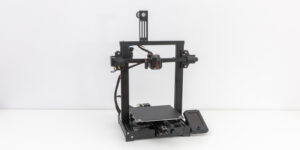
Standout Features
- Updated motherboard with silent TMC 2208 stepper motor drivers
- Full-color screen with updated UI
- Carborundum glass bed
Technical Details |
|
|---|---|
| Technology | FDM |
| Build volume | 220 x 220 x 250 mm |
| Min. layer height | 120 microns |
What We Like
- Beginner-friendly
- Easy to operate
- Filament offers cheap minis
- Extensive community support
Could Be Better
- Inferior surface finish relative to SLA 3D printers
- Slow print speed with full print bed
What to Prioritize When Buying a 3D Printer for Miniatures?
Now that we’ve looked at some of the best 3D printers for miniatures, it is also important to go evaluate the features that are important. In this section, we will go over the major things that you need to consider when getting a 3D printer for you to print miniatures with. This will help you set your priorities and select the printer that best suits your needs.
What Kind of Miniatures Do You Want to 3D Print?
Non-minis (terrains, props, scenery)
Games like Warhammer and D&D can have an elaborate terrain setup. Since these terrain prints are usually of larger sizes, it makes sense to print them with an FDM 3D printer instead of a resin machine.
The large build volume and cheaper material costs of filament printers are great for printing terrains and other props. FDM printers also allow you to use the prints right away, as they barely need any post-processing.
Miniatures & figurines
You can commonly find D&D minis in two different sizes. A tabletop version of 54 mm or a mini version of 28 mm.
By fine-tuning your FDM 3D printer, you print 28mm minis with it in decent quality. However, you will have to sacrifice finer details and surface finish. Because of this, a resin 3D printer is a better choice for these sizes of miniatures.
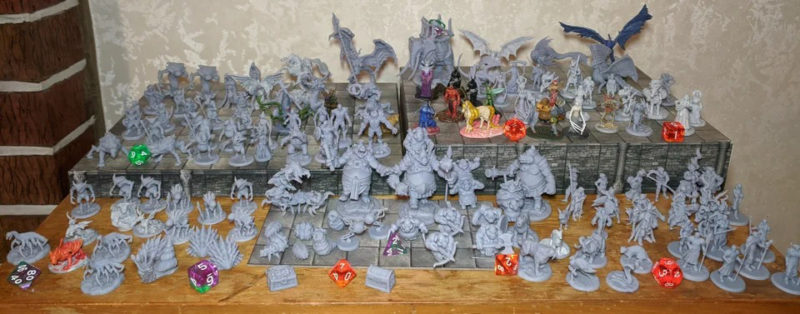
Keep in mind that figurines of this size can quickly get expensive with resin 3D printers. So, if the quality is not a pressing issue, a finely tuned FDM 3D printer can give you similar results at considerably lower 3D printing costs.
Bed size
A bigger build platform has its own set of merits and drawbacks. Looking at resin 3D printers, a larger build platform gives a number of drawbacks. Most notably a larger resin reservoir, a bigger machine size, and higher peeling forces.
On the other hand, a bigger build plate lets you print more objects at once. This is beneficial when you want to print miniatures in batches, for example.
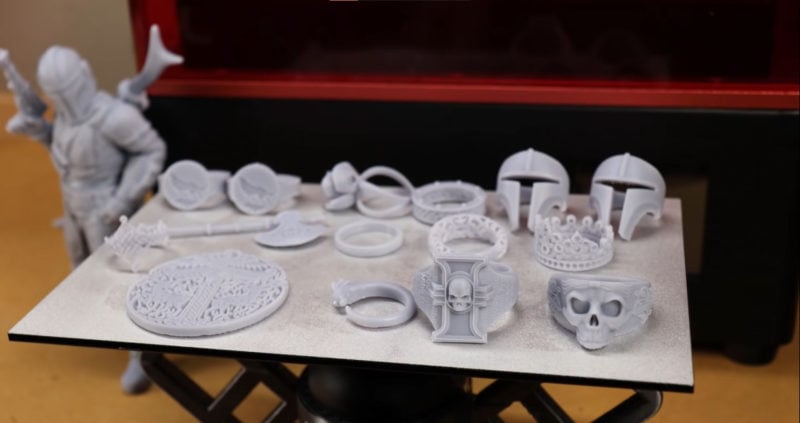
If you really need to print a lot of minis at once or want to print larger models, the Elegoo Saturn 2 is a great choice.
If you’re going to be printing a lot of single, small-sized minis, and don’t wish to spend too much money on resin, then you’re better off with smaller 3D printers such as the Anycubic Photon Mono 2 or Phrozen Sonic Mini 4K.
Layer Thickness & Print Quality
Layer thickness dictates the level of surface finish your 3D-printed mini will have. The smaller the layer height, the better the surface finish. An MSLA 3D printer like the Photon Mono M5S can give you a layer height of just 25 microns or 0.025mm. While with DLP 3D printers, you can still get a respectable layer height of just 50 microns or 0.50mm.
With FDM 3D printers, the layer height of the model depends on the size of the extrusion nozzle. Usually, you can go as low as 100 microns or 0.1 mm. To achieve this layer height on an FDM printer, you do need to do quite a bit of fine-tuning.

You also need to keep in mind that the lower the layer height, the more time the 3D printing takes. A lower layer height for minis makes sense, but for terrains and other props, it is best to use a higher layer thickness. This will save you time and decrease the chances of print failure because of lengthy 3D printing times.
Speed
No matter which printing method you choose, printing speed is an important factor. The chance of a print failing decreases and you’ll be able to 3D print your models in less time.
Resin printers produce miniatures at significantly faster print speeds than FDM machines. In terms of vertical height, a resin 3D printer like the Phrozen Sonic Mini 4K can print at a maximum speed of 80 mm/hour.
No matter how many models are on the build plate, this speed stays the same. No matter if you only print one model or ten miniatures, it will take almost the same amount of time to do so. This is because the screen of LCD printers cures an entire layer all at once.
On the other hand, if you want the quality of the miniature models to be better with an FDM printer, you will have to limit how fast you can print. Print speed has a big effect on the quality of your prints, and a slower speed will give you better miniature printing results. Plus, the printing time increases with the addition of more models on the build plate.
Because of these things, a resin printer is the best option when printing miniatures more quickly. It will significantly decrease your printing time without decreasing miniature quality, especially if you 3D print miniatures in batches.
Build Quality
The print quality you obtain from your machine is influenced by a number of factors, one of which is its build quality. Z-axis rails, an LCD display, projection LEDs, the hot end, and the extruder all have a role in how well your miniatures print.
A well-built machine allows you to duplicate finer details with more precision and with fewer failures. It lasts a long time, is less likely to break down, and you don’t have to find parts for it very often. This saves money on repairs and makes sure you have a great time 3D printing miniatures.
Resin printers are regarded as sturdy and reliable, with fewer moving components. That said, it’s still important for you to look out for the quality of the screen on LCD printers and the stability of linear rails. Most user reviews and customer sites talk about these kinds of things.
Support
As you learn more about 3D printing miniatures, you’ll learn that even with the best 3D printer for miniatures, support is important. Before you decide on a machine, it’s a good idea to look at both the manufacturer’s help page and user forums.
Elegoo, Anycubic, Creality, and Phrozen are all well-known companies that make 3D printers. They offer great customer service and help after the sale, and they have a lot of user groups. Almost every 3D printer on this list has a community website or a group where people can talk about it.
We consider these platforms to be essential since they provide invaluable insight into the devices, the problems their users face when printing high-resolution miniatures, and the perspective of actual users. Even if you want to buy a 3D printer that isn’t on this list, look it up on the Internet and try to find out as much as you can about the company’s customer service.
Resin Printer XY resolution
Just as layer thickness refers to the Z-axis resolution and the vertical plane, XY resolution is measured on a horizontal plane. In the case of SLA 3D printers, it is the spot size of the laser. With DLP 3D printers, it is the individual pixel size of the screen.
Normally, the lower the XY resolution, the better the quality of the 3D-printed object will be. A very low XY resolution allows the 3D printer to produce even the finest of details. The end result is a 3D print with better quality.
Most of the best resin 3D printers for miniatures today have an XY resolution of 35~50 microns. This high resolution is equivalent to the size of fine sand grains. It’s more than enough to reproduce fine details of the 3D models you are working with.
Printers like the Phrozen Sonic Mini 8K can go as low as 22 microns. It’s probably overkill for printing miniatures but comes in handy with for good quality models with fine textures. Armor textures, hair quality, and the smoothness of your minis all come out great with such a high level of printing resolution.
Material
The choice of material plays a key element in any 3D printing application. In comparison with FDM 3D printing, the cost of resin printing material is on the higher side. You are also limited to the resins that are compatible with your specific resin 3D printer.
Overall, there are still plenty of material options when working with liquid resin. You can even use special resins with which you can cast your own metal figurines.
In FDM 3D printing, the most commonly used materials are PLA, ABS and PETG. PLA filament is easy to 3D print, but difficult to post-process. While ABS is difficult to 3D print, you can smoothen it out using an Acetone bath, for example, and get a great surface finish.
All of these materials are cheaply available and you can expect quality prints once you have the 3D printing settings dialed down perfectly.
The Best 3D Printer for Miniatures: Resin Printers vs FDM
Choosing between a resin vs filament 3D printer for miniatures comes down to your specific needs. There are a few factors that are of particular importance.
Size
FDM 3D printers are available in larger sizes than their resin counterparts for the same price. For instance, both the Anycubic Photon Mono 2 and the Creality Ender 3 V2 Neo are available for $199.00.
The Ender 3 V2 has a build volume of 220 x 220 x 250 mm, whereas the Photon Mono 2 has a print area of 165 x 89 x 143 mm. The Ender 3 has a considerably bigger print bed and Z-height. This gives you more room to print multiple models at once and to 3D print larger models.
If you’re someone who wants to create larger objects, an FDM 3D printer makes more sense than a resin 3D printer for miniature printing.
Quality
The quality of parts produced on a resin 3D printer will always be superior to any FDM 3D printer. The small layer heights and a high XY resolution result in no visible layer lines. You get a smooth surface finish, higher quality of details, and the part looks as good as an injection molded component.
However, this does not mean that printing miniatures with an FDM 3D printer is worse. If you take the time and effort to finely tune your FDM 3D prints, you can still get some very high-quality minis from your FDM 3D printer.
Material
As discussed earlier, the liquid resin material is more expensive than FDM filaments. Aside from an increased cost in the 3D prints, any print failures also lead to higher losses. You’re also limited by the choice and colors of resin materials.
In the case of FDM, you have a variety of materials available and can easily get them anywhere in the world. They’re also less pricey, making it easy to start 3D printing on a budget.
Operation
Even the best 3D printer for miniatures is going to be a messy machine. You need to carefully handle the resin and be sure to print in a well-ventilated area. The resin material emits harmful toxic fumes which aren’t safe for longer periods.
After printing, you need to wash and cure your high-resolution prints with a UV curing station. This requires an extra set of machines and increases lead times. This also increases initial, recurring, and maintenance costs for the cleaning equipment.
FDM 3D printers for miniatures are easy to operate and very beginner-friendly. There are relatively few risks involved in printing miniatures with them. You can use them safely around children and in classrooms. PLA is the safest material to 3D print, with practically no VOCs or other harmful fumes when using a reputable brand.
FDM 3D printer parts are also widely available and replaceable without too many complications. They’re relatively inexpensive and easy to fix on the printers. There are also several guides, forums, and helpful software for FDM 3D printers, which are all designed to make it easy to operate these machines.
Cost
A big deciding factor in buying a 3D printer for miniatures is the total cost. There is a lot more to consider than just the retail price of the printer.
If your goal is to sell D&D minis, you must add operation costs, labor costs, overheads, failure costs, and material costs to your calculations. That said, if you’re 3D printing miniatures consistently and in high volumes, you will still quickly break even on the costs of a resin printer.
From that perspective, resin 3D printers for miniatures are definitely costlier than an FDM alternative. When comparing these two, it is important to compare their cost vs quality and evaluate for yourself which is more important to you.
What Printer Resolution Do You Need for Printing Miniatures?
In resin printers, 50 microns of XY resolution gives a pretty good surface finish while capturing all the details of the model. However, for the highest quality, you are best off getting a 4K/6K/8K resin printer. 3D models printed on an LCD printer with a 4K+ screen offer much higher resolutions and capture all the fine details.
For FDM printers, 0.2 mm (200 microns) layer height provides a good balance between speed and quality. Needless to say, this does not offer the same amount of detail as a resin print.
How Long Does It Take to 3D Print a Miniature?
The time for printing minis depends on various parameters. You can print a miniature in as little as 3-4 hours or as long as 1-2 days. The layer height and the exposure time play a critical role.
In resin printing, the total time required to print multiple minis at the same time is dependent only on their height, and not their number.
With FDM 3D printers for miniatures, as the number of minis increases, the time required for printing them increases proportionately. Also, on an FDM machine, you might need to slow down the printing speed to achieve maximum quality.
How Much Does It Cost to 3D Print a Miniature?
There is no fixed price that we can quote for 3D printing a miniature. You have to take into account the cost of the materials, 3D printer, STL files, post-processing, etc. Though, an FDM 3D printed mini would cost you much less than a similar resin 3D printed component.
Here is a good Reddit thread that goes into detail about this topic.
Where to Download Miniatures to 3D Print?
There are a lot of websites from which you can download miniatures. Some of the popular ones for miniature printing are Thingiverse, MyMiniFactory, CGTrader, Cults3D, Sketchfab, and Gambody.
Can You 3D Print Props and Terrains?
Yes, you can 3D print props and terrains on both FDM and resin printers. For terrains specifically, FDM printers do a great job at printing large terrains at once. With some fine-tuning, you can print high-quality terrains on your printers and bring to life your tabletop game.
Is It Legal to 3D Print Warhammer D&D Models?
It’s legal to 3D print Warhammer and D&D miniatures as long as you’re using them for personal use. In many cases, if you’re 3D printing a model that you’ve designed and printed from scratch, it is completely legal.
However, if you’re earning money or listing copyright designs and models on marketplaces, it is considered to be unethical and illegal. The original designers and companies like Games Workshop can file an intellectual property (IP) claim against you.
Can You Sell 3D-Printed Miniatures?
It’s somewhat of a gray area. You cannot sell any 3D-printed miniatures that are direct replicas of the original copyrighted designs. The designs are the property of the individual owners, and it is illegal to sell these miniatures.
But, if you’re completely designing and 3D printing miniatures all on your own, you can sell these models. Your design should not infringe upon the original design of the creator. As long as it’s new and original, you can sell your 3D-printed miniatures.
Conclusion
If you’re looking for a simple recommendation, we’d say that the Elegoo Saturn 2 is the best 3D printer for miniatures. It’s reasonably priced, has a large build volume, and produces excellent prints.
Both the Phrozen Sonic Mini 8K and the Creality CR-M4 are our second-best 3D printers for miniatures. The Mini 8K’s high-resolution screen excels at producing intricate patterns and textures. It’s great for printing models with lots of features, like army men, animals, and intricate designs.
The CR-M4 on the other hand, is one of the best FDM printers for 3D printing big models and terrains at once.
We’d like to know what you think about all the printers in this list. Please leave a comment below if you have any questions or ideas.
